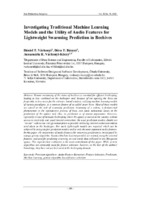Investigating Traditional Machine Learning Models and the Utility of Audio Features for Lightweight Swarming Prediction in Beehives

Megtekintés/
Metaadat
Teljes megjelenítés
Link a dokumentumra való hivatkozáshoz:
Gyűjtemény
Absztrakt
Remote monitoring of the status of beehives is essential for efficient beekeeping,
leading to less workload on the beekeeper and, because of not opening the hives too
frequently, to less stress for the colonies. Sound analysis, utilizing machine learning models
of various paradigms, is a common feature of so-called smart hives. Most of these models
are aimed at the task of swarming prediction. Swarming of a colony, a fundamental
phenomenon in the reproductive process of bees, can cause substantial losses in the
production of the apiary and, thus, its prediction is of utmost importance. However,
especially in case of nomadic beekeeping where the apiary is moved to the country without
access to electricity and good internet connection, the used prediction models should run
“on-site” with as low energy consumption as possible and using internet connection only to
send alerts to the beekeeper. For such, lightweight models are required which can be
achieved by using simpler prediction models and/or only the most important audio features.
In this paper, the importance of audio features for swarming prediction is investigated by
using a genetic algorithm. Various Machine Learning models are trained, using the selected
features, and used for predicting swarming on real-world data collected in one Hungarian
apiary. This experimental evaluation is the main contribution of this paper. While genetic
algorithms are commonly used for feature selection, however, to the best of the authors'
knowledge, they have not yet been used in the beekeeping domain.
- Cím és alcím
- Investigating Traditional Machine Learning Models and the Utility of Audio Features for Lightweight Swarming Prediction in Beehives
- Szerző
- Várkonyi, Dániel T.
- Bányai, Dóra T.
- Várkonyi-Kóczy, Annamária R.
- Megjelenés ideje
- 2024
- Hozzáférés szintje
- Open access
- ISSN, e-ISSN
- 1785-8860
- Nyelv
- en
- Terjedelem
- 17 p.
- Tárgyszó
- precision apiculture, audio feature extraction, feature selection, prediction, machine learning, genetic algorithm based feature selection
- Változat
- Kiadói változat
- Egyéb azonosítók
- DOI: 10.12700/APH.21.10.2024.10.18
- A cikket/könyvrészletet tartalmazó dokumentum címe
- Acta Polytechnica Hungarica
- A forrás folyóirat éve
- 2024
- A forrás folyóirat évfolyama
- 21. évf.
- A forrás folyóirat száma
- 10. sz.
- Műfaj
- Tudományos cikk
- Tudományterület
- Műszaki tudományok - multidiszciplináris műszaki tudományok
- Egyetem
- Óbudai Egyetem
